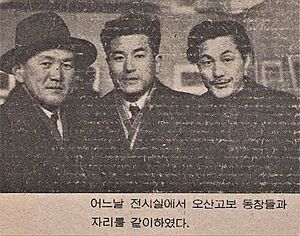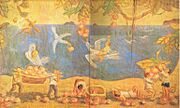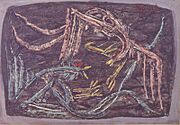Lee Jung-seob facts for kids
Quick facts for kids
Lee Jung Seob
|
|||||||||||
|---|---|---|---|---|---|---|---|---|---|---|---|
| 이중섭 | |||||||||||

Lee Jung seob on the right, with Kim wol Yong on the left.
|
|||||||||||
|
|||||||||||
Lee Jung-seob (born April 10, 1916, in Pyeongannamdo – died September 6, 1956, in Seoul) was a famous Korean artist. He is best known for his oil paintings, especially White Ox.
Contents
Life Story
Early Years and Art
Lee Jung-seob grew up in a wealthy family in Pyongwon County, which is now in North Korea. His family owned a lot of land. After his father passed away in 1918, his older brother took care of him.
Lee found his love for art early. When he was young, he saw copies of old Goguryeo tomb murals. These large, colorful wall paintings amazed him. In 1930, he started studying art at Osan High School. This school helped train future leaders who were against Japanese rule in Korea. Lee was very good at art and was inspired by his teacher, Im Yong Ryeon. His family's money helped him follow his dream of becoming an artist.
In 1932, Lee went to Japan to study painting at Teikoku Art School. He later moved to Bunka Gakuin, a more modern art school. There, he developed a strong, free drawing style. He also started painting bulls a lot, seeing himself in them. He even showed his art in exhibitions and became well-known. At Bunka Gakuin, he met Yamamoto Masako, who later became his wife.
Lee finished art school in 1941 and returned to his hometown in 1943. He kept painting and showing his art even during the war. In April 1945, Masako came to Korea, and they got married. Their first child was born in 1946 but sadly died from a serious illness. This loss deeply affected Lee. He painted A Child Flies with a White Star to remember his child. His sons, Taehyun and Taeseong, were born in 1947 and 1949.
The Korean War Begins
After World War II, Korea was divided. Different governments took control in the north and south. Lee's brother was arrested in Wonsan. Officials watched Lee closely because his family was wealthy and his wife was Japanese.
When the Korean War started in 1950, Wonsan was bombed. Lee, his wife, and two sons had to leave their home and move to Busan in South Korea. He had to leave his mother and many of his artworks behind. This is why we don't have much of his art from before 1950. His family became very poor. They moved to Jeju Island for a warmer climate.
Life on Jeju Island
Lee and his family found a warm and pleasant life in Seogwipo, on the southern coast of Jeju Island. They were poor but mostly happy there for about a year. Lee painted A Family on the Road (1951), which shows a family traveling with a bull. Despite the hard times, Lee drew and painted the beautiful scenery around him. He found new ideas in seagulls, crabs, fish, and his growing children. He started drawing children with fish and crabs in a simple, clear style. By the end of 1951, they were struggling with money and health, so they moved back to Busan.
Jeju Island was very important to Lee's art. He created some of his most famous works there, like Boys, Fish, and Crab (1950), Song of the Ocean of Lost Hometown (1951), and The Sun and Children (1950s).
Family Separation
Because of their poverty, Masako and their children went to Japan in July 1952. This was supposed to be a temporary plan. Lee could not get a visa to join them, and he became very sad. He sent letters and postcards with drawings to his wife and children, showing how much he loved and missed them. He worked as a crafts teacher and continued to paint. Many of his works from this time were lost in a fire. Lee later moved back to Seoul.
From 1954, Lee taught in Tongyeong. For the first time since the war, his life was more stable. He painted many artworks there, including his famous Bull series. He also had his first solo art show in Tongyeong.
Lee's friend, the poet Ku Sang, said that Lee struggled to sell his art so he could reunite with his family. The pain of not being able to see them made him very sad. Lee painted Family of Poet Ku Sang (1955), showing his longing for his own family. He was never able to save enough money to move to Japan. He only met his family once for five days in Tokyo in 1953.
In 1955, he had another art show to try and sell his works. Even though some paintings sold, he didn't get the money and remained in debt. He became very depressed, feeling like he had failed his family and himself as an artist.
Later Life and Death
Lee struggled with sadness and loneliness because he missed his family and faced many hardships. He moved between Seoul, Daegu, and Tongyeong. He also drew pictures for magazines.
On September 6, 1956, Lee passed away from a liver illness at age 40 in a Seoul hospital. His friends had him cremated and sent some of his ashes to his wife in Japan. They also put up a tombstone for him in Seoul.
Artistic Style and Works
How His Art Developed
Lee started learning art from his high school teacher, Im Yong Ryeon. Im had studied art in the United States. Lee loved the old Goguryeo tomb murals, and this showed in his art. He used strong lines, deep colors, and animal symbols. He also learned modern painting styles like watercolor and oil painting.
In Tokyo, Lee's art was influenced by styles like Fauvism and Expressionism, which use bold colors and strong emotions. But his art always showed Korean life. He painted everyday scenes, rural landscapes, and his family's life. He helped bring Western art styles to Korea. He was inspired by artists like George Rouault and Pablo Picasso.
Lee always wanted to paint a very large mural in a public place for everyone to enjoy. But because of the Korean War, his dream never came true.
Major Art Series
Tinfoil Paintings
Lee couldn't afford regular art supplies, so he found a new way to create art. He used pieces of tinfoil from cigarette packs. He would scratch lines into the tinfoil with a sharp tool, then apply paint and wipe it away. This left only the lines tinted. Even though the image was flat, the deep lines made it look like it had many layers. The shiny tinfoil also made the art look special. This technique was inspired by old Korean art, like Goryeo celadon pottery with inlaid designs. Lee made about 300 tinfoil paintings.
His tinfoil paintings showed scenes of poverty but also his happiest moments in Seogwipo. They often showed his family playing with crabs, fish, and flowers. These tinfoil paintings were like rough drawings for the big murals he hoped to paint. This is his most famous type of work. Three of these paintings are in the Metropolitan Museum of Art in New York.
Some of his tinfoil paintings include Twins (1950) and Children Playing in the Peach Garden (1954).
Letter Paintings
After Lee was separated from his family, he regularly sent letters to his wife and children in Japan. At first, his letters were full of love and hope that they would be together soon. Many letters had beautiful drawings for his family, showing his deep love for them.
However, from mid-1955, Lee became very sad and almost stopped writing. About sixty of his letters have survived. These letters, like Artist Drawing His Family (1953-54), show how his daily life connected to his art. They are also important artworks themselves.
Children in Art
Many of Lee's paintings focused on children, especially his own. He was inspired by images of children playing on old Korean pottery. Small statues of baby Buddha also gave him ideas for his child drawings. After his first child passed away, Lee buried a drawing of children playing with him. He hoped his child would play with other children in the afterlife.
Even though Lee faced many hard times, poverty, and war, his paintings often showed the happy, childlike beauty of days spent with his family.
His works include Family with Chickens (1954-55), Twins (1950), The Sun and Children (1950s), and Children Playing in the Peach Garden (1954).
Cows in Art
Throughout his life, Lee painted many pictures of cows. The cow was very special in his art. It represented the Korean people and their deep roots. The white bull, in particular, became a symbol for Korea and its people. Some say that painting cows was a brave choice when Japanese rule tried to stop Korean traditions. After the war, he painted bulls again, showing strength and determination.
Lee used bright colors and strong brushstrokes in Bull (1953). This painting showed his strong hope for reuniting with his family. Lee once said, "When I look into a cow's big eyes, I know happiness."
Other paintings include White Ox (1954), A White Bull (1953-54), and Gray Bull (1956).
Lee Jung Seob Art Gallery
In 1995, the Lee Jung Seob Art Gallery was built in Seogwipo, Jeju. It is on "Lee Jung-Seob's Art Street." The museum is on a path that leads to the house where Lee and his family lived in Seogwipo. Another path from the house goes to the museum.
A copy of his painting Fantasy of Seogwipo (1951) is on display there. It shows birds and people living happily together. The gallery has 11 of Lee's original artworks and many copies. It also has many of his original letters to his wife. Because Lee's art has become very famous and valuable, it is hard for the museum to buy more of his original pieces. The second floor sometimes shows art by modern Korean artists.
His Legacy
An art show held after Lee's death in 1957 made his artworks very popular. Lee became the first Korean artist to have a piece of art in the permanent collection of the Museum of Modern Art in New York.
Lee is seen as one of the most important artists in Korea. He wanted to be known as a painter for the Korean people. His art showed unique Korean modernism while keeping traditional Korean beauty. His works show a person's hopes and wishes during times of war, poverty, and sadness. His life story reminds us how war can affect people and families.
On April 10, 2012, Google celebrated Lee Jung-Seob's 96th birthday with a Google Doodle that showed one of his famous "Bull" paintings.
Paintings
- Works of Lee Jung Seob
Lee Jung Seob created many artworks. Some of his paintings include:
- White Ox – 흰 소, 1954 (shown in the Museum of Modern Art)
- Fighting Ox – 싸우는 소
- Fish and the Kids – 물고기와 아이들, 1950
- The Family and the Dove – 가족과 비둘기, 1956
See also
- List of Korean painters
- Korean art







